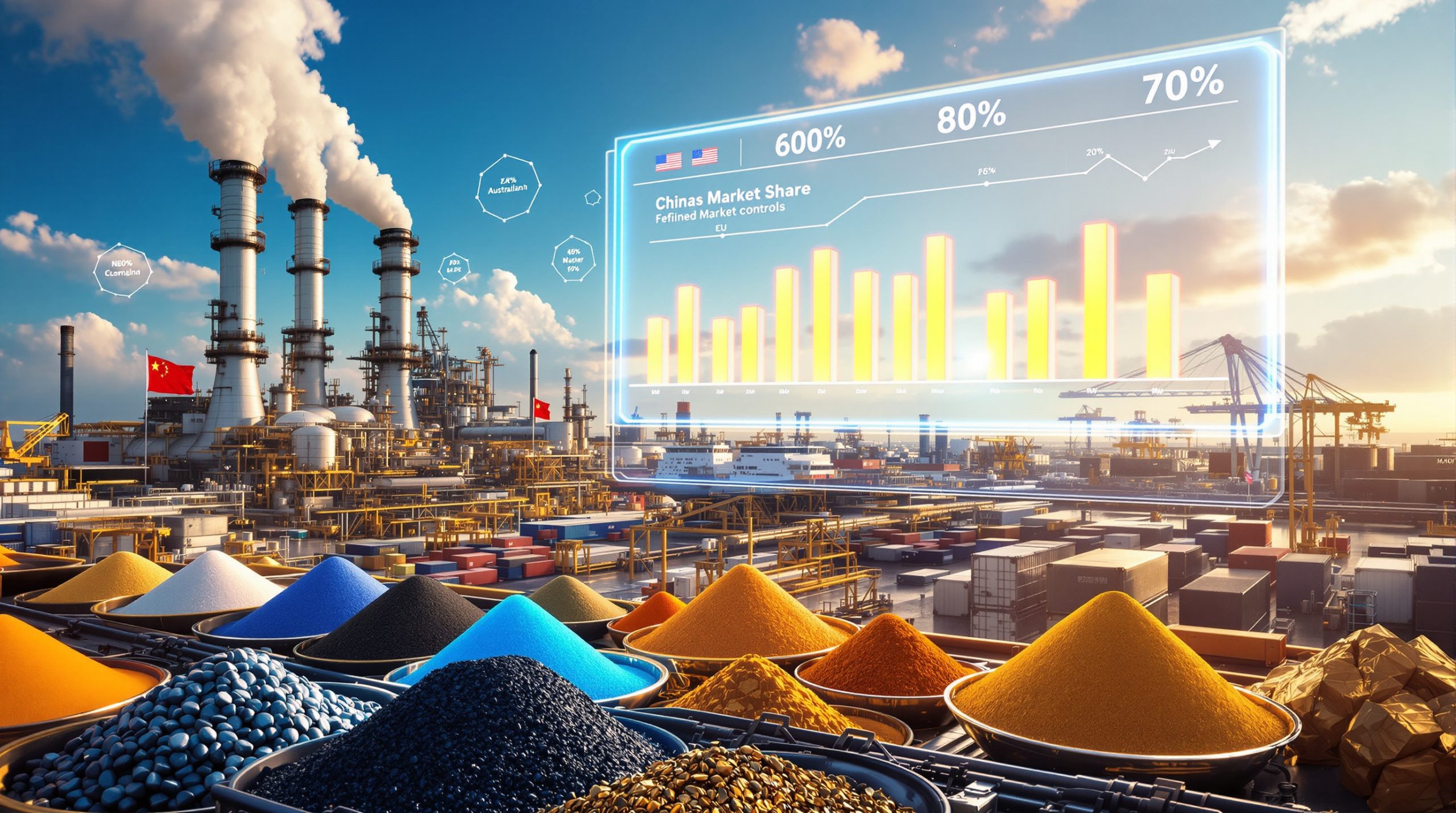Indonesia's Strategic Tin Market Position
Indonesia maintains a commanding presence in the global tin industry, ranking as the world's second-largest producer behind China. The nation contributes approximately 21% of worldwide mine production, establishing itself as a critical supplier for international markets. The successful implementation of mining evolution trends will be crucial for Indonesia's long-term competitiveness. According to the U.S. Geological Survey's Mineral Commodity Summaries 2024, Indonesian mine production reached approximately 80,000 metric tons in 2022, cementing its position in global supply chains.
The archipelago nation's tin resources are predominantly concentrated in the Bangka-Belitung Islands province, which accounts for roughly 90% of national production. These islands contain extensive onshore and offshore alluvial tin deposits that have supported industrial operations for decades. Indonesia's proven reserves total an estimated 800,000 metric tons, representing 17% of global tin reserves and providing substantial foundation for long-term production sustainability.
Geographic Advantages and Supply Chain Integration
Indonesia's strategic location in Southeast Asia positions the country as an optimal supplier to major electronics manufacturing hubs throughout the region. The proximity to key consumption centres in China, Japan, and South Korea provides logistical advantages that have historically strengthened trade relationships. Electronics manufacturers in these three countries collectively consume approximately 60% of global tin solder production, creating natural market synergies with Indonesian suppliers.
The International Tin Association's consumption analysis reveals that approximately 50% of global tin demand originates from solder applications, primarily in electronics manufacturing. Additional demand drivers include tin chemicals at 17%, tinplate applications at 14%, and various specialised uses including battery systems and advanced alloys comprising the remaining 19% of consumption patterns.
Understanding the Production Crisis Origins
Indonesia's tin sector experienced dramatic disruption beginning in late 2023 when government authorities launched comprehensive enforcement campaigns targeting unauthorised mining operations. Production levels declined from approximately 76,000 metric tons in 2021 to an estimated 49,900 metric tons in 2024, representing a substantial 34% reduction over the three-year period.
The enforcement actions specifically targeted operations lacking proper environmental permits, mining licences, and compliance with Indonesian regulatory frameworks. Furthermore, these activities necessitated comprehensive mine reclamation innovation approaches to address environmental damage. According to CRU Group analysis, enforcement efforts affected tens of thousands of small-scale miners and smelters that had operated in regulatory grey areas for extended periods.
Many of these operations lacked adequate environmental safeguards and worker safety protocols. Consequently, the government implemented comprehensive waste management solutions to address legacy environmental issues.
Regulatory Framework Transformation
Indonesia's mining sector operates under the comprehensive RKAB system, requiring all mining companies to submit detailed annual work plans and budgets for government approval. The RKAB framework covers production targets, environmental management protocols, safety procedures, and community engagement initiatives. Following the enforcement period, authorities tightened RKAB requirements and reduced approval validity from three years to two years.
The government simultaneously introduced stricter export licensing requirements that prioritise companies demonstrating downstream processing capabilities. These regulations favour operations with integrated refining facilities and value-added manufacturing capacity. Export quota allocations now emphasise companies capable of producing tin at 99.9% purity levels and those developing tin-based chemical products or specialised alloys.
Environmental compliance became a central focus of the regulatory overhaul, with authorities requiring comprehensive environmental impact assessments and remediation plans for previously non-compliant sites. Companies seeking to resume operations must demonstrate adherence to updated environmental standards and implement monitoring systems for ongoing compliance verification.
Recovery Timeline and Production Projections
President Prabowo Subianto announced in October 2025 that Indonesia tin output 2026 should return to normal levels following the completion of sector reforms and facility upgrades. According to Indonesia's president sees country's tin output back to normal in 2026, the government's structured approach involves phased rehabilitation of compliant operations while maintaining strict oversight of environmental and safety standards.
The International Tin Association projects Indonesian refined tin production of approximately 57,000 metric tons for 2025, representing a 14% increase from 2024 levels but remaining 19% below historical norms. This gradual recovery trajectory reflects the time required for facility assessments, equipment upgrades, and regulatory compliance verification.
State Enterprise Production Targets
PT Timah Tbk, Indonesia's state-owned tin producer, has established ambitious production expansion goals despite current operational challenges. In addition, successful mining investment strategies will be essential for achieving these targets. The company produced 6,870 metric tons in the first half of 2025, down 29% compared to 9,680 metric tons in the same 2024 period.
| Year | Production Target | Key Initiatives |
|---|---|---|
| 2025 | 22,000 MT | Facility modernisation and compliance upgrades |
| 2026 | 30,000 MT | Integrated operations and capacity expansion |
| Long-term | 80,000 MT | Full utilisation of processing capabilities |
The company's strategic plan emphasises downstream integration and value-added processing to align with government priorities. PT Timah is investing in smelter modernisation, environmental remediation, and workforce development programmes to support the production ramp-up schedule.
Global Market Response to Indonesian Recovery
The normalisation of Indonesian tin production carries significant implications for worldwide supply-demand dynamics and pricing stability. Current market conditions reflect the impact of reduced Indonesian output, with London Metal Exchange tin prices reaching $32,500 per metric ton in September 2024, the highest levels since 2022.
The International Tin Association forecasts a global refined tin market deficit of 7,600 metric tons for 2025, compared to approximately 12,000 metric tons in 2024. Indonesian production recovery represents a critical factor in addressing this supply shortfall and stabilising international markets.
Supply Chain Stabilisation Effects
Manufacturers across electronics, automotive, and renewable energy sectors have experienced supply chain pressures due to Indonesian production volatility. Companies have implemented various strategies to manage tin procurement challenges, including:
• Extended contract terms with alternative suppliers
• Increased inventory holdings to buffer supply disruptions
• Development of supplier diversification programmes
• Investment in tin recycling and secondary supply sources
Fastmarkets analysis indicates that Indonesian production recovery by 2026 could ease tight supply conditions and reduce price volatility, though structural market deficits are expected to persist through 2027. Growing demand from electric vehicle and renewable energy applications continues to outpace supply growth from all producing regions.
Electronics manufacturers have been particularly affected by supply constraints, as tin solder applications require consistent material availability for production planning. Lead-free solder alloys mandated by EU RoHS directives typically contain 96-99% tin, making supply reliability essential for compliance and manufacturing continuity.
Investment Opportunities in Indonesia's Tin Sector
The comprehensive reform and modernisation of Indonesia's tin industry creates multiple investment pathways for both domestic and international stakeholders. However, investors must consider comprehensive sustainability transformation approaches when evaluating opportunities. The government has introduced attractive incentive packages to encourage legitimate investment in compliant operations.
Indonesia's Investment Coordinating Board announced that tin processing facilities demonstrating downstream integration capabilities would be eligible for tax holidays extending up to 20 years under specified conditions. These incentives specifically target companies developing refining capacity, tin chemical production, or specialised alloy manufacturing.
Downstream Processing Development
Current regulations require tin mining companies to demonstrate downstream processing capabilities or establish partnerships with qualified processors. This mandate creates opportunities for technology transfer, equipment supply, and joint venture arrangements. Priority applications include:
• Advanced smelting and refining facility construction
• Environmental compliance technology implementation
• Automated processing and quality control systems
• Tin chemical and specialty alloy production capacity
The Indonesian government is implementing blockchain-based traceability systems by 2026, positioning the country as a leader in supply chain transparency. This technological infrastructure creates opportunities for companies specialising in digital supply chain solutions and certification systems.
Companies seeking to participate in Indonesian tin sector recovery must navigate stringent environmental and social responsibility requirements. The Responsible Minerals Initiative notes that Indonesian regulatory reforms align with international responsible sourcing standards, potentially positioning Indonesian tin as preferred material for companies with rigorous ESG requirements.
Industrial Sectors Benefiting from Supply Normalisation
Several key industries stand to gain significantly from Indonesia tin output 2026 recovery and subsequent market stabilisation. The electronics sector, representing approximately 50% of global tin consumption, faces the most direct impact from supply reliability improvements.
Electronics and Technology Manufacturing
The electronics industry relies heavily on tin-based solders for printed circuit board assembly and semiconductor packaging applications. Common lead-free solder compositions include SAC305 (96.5% Sn, 3% Ag, 0.5% Cu) and similar high-tin-content alloys mandated by environmental regulations.
Deployment of 5G infrastructure and proliferation of IoT devices will require approximately 15,000-20,000 additional metric tons of tin annually by 2027, according to CRU Group analysis. This demand growth encompasses network equipment manufacturing, device assembly, and connectivity component production.
Electric Vehicle and Renewable Energy Applications
Electric vehicles contain approximately 3-5 times more tin content than conventional vehicles due to extensive electronics systems, battery management components, and power control modules. The automotive sector's electrification trend creates sustained demand growth for tin-based materials and soldering applications.
Solar photovoltaic installations require tin-based solders for cell interconnections, with average tin content of 8-12 grams per kilowatt of installed capacity. The International Tin Association's renewable energy research indicates this application segment will drive significant additional tin demand as global solar deployment accelerates.
Wind energy systems also utilise tin in electronic control systems, power conditioning equipment, and grid interconnection hardware. The expanding renewable energy infrastructure represents a growing consumption segment that benefits from stable tin supply availability.
Potential Recovery Timeline Risks
Despite optimistic government projections for Indonesia tin output 2026 normalisation, several factors could potentially impact the planned recovery schedule. Implementation challenges, regulatory coordination issues, and market dynamics all present variables that could affect timing and production levels.
Regulatory and Implementation Challenges
Indonesia increased tin mining royalties from 3% to 5% in 2024, potentially impacting project economics for smaller producers and affecting investment decisions. Higher operating costs could delay capacity restoration for marginal operations or discourage new entrants from participating in sector recovery.
Mining Weekly analysis indicates that bureaucratic bottlenecks in RKAB approval processes have historically delayed production startups by 3-6 months. Inconsistent enforcement between different regional mining offices creates uncertainty for operators attempting to navigate compliance requirements.
Environmental remediation requirements present another potential timeline risk. Companies operating previously illegal sites must conduct comprehensive environmental impact assessments and implement remediation plans before receiving production licences. This process typically requires 6-12 months according to Indonesian environmental regulations.
Operational and Technical Constraints
Equipment modernisation and technology integration represent significant technical challenges for companies attempting to resume operations. Many facilities require substantial upgrades to meet current environmental and safety standards, potentially extending rehabilitation timelines beyond initial projections.
Skilled workforce development presents another constraint, as the enforcement period displaced numerous experienced miners and technicians. Companies must invest in training programmes and workforce development to restore operational capabilities, which requires time and capital resources.
Infrastructure limitations including port capacity, transportation networks, and logistics systems could constrain production growth even as mining operations resume. The concentration of tin production in the Bangka-Belitung Islands creates potential bottlenecks if infrastructure cannot support increased throughput.
Global Tin Market Context and Competition
Indonesia's production recovery occurs within broader global tin market dynamics that influence the sector's overall trajectory through 2026 and beyond. Understanding competitive positioning and international supply patterns provides context for Indonesian recovery significance.
International Production Landscape
Global tin production remains concentrated among a relatively small number of producing countries, with the top five nations accounting for approximately 80% of worldwide output. Current production estimates for major producers include:
| Country | Annual Production (MT) | Market Share |
|---|---|---|
| China | 85,000 | 28% |
| Indonesia | 65,000 (pre-crisis) | 21% |
| Myanmar | 16,000 | 5% |
| Peru | 18,000 | 6% |
| Bolivia | 17,000 | 6% |
China maintains its position as the world's largest tin producer, with production levels remaining relatively stable around 85,000-90,000 metric tons annually. Chinese operations benefit from integrated supply chains and substantial domestic consumption, providing market stability during international supply disruptions.
Myanmar's tin production faces ongoing uncertainty due to political instability and international sanctions concerns, making Indonesia's recovery increasingly important for supply diversification. This situation highlights the strategic value of Indonesian production normalisation for global market stability.
Demand Growth Drivers
The International Tin Association projects global tin demand growth of 3.2% annually through 2027, driven primarily by electronics manufacturing expansion in Asia and accelerating electric vehicle production worldwide. This sustained demand growth supports market fundamentals even as Indonesian supply recovers.
Digital infrastructure development, including data centres, telecommunications networks, and computing hardware, represents an expanding consumption segment. These applications require high-reliability solder joints and specialised tin-based materials for performance-critical applications.
The renewable energy transition creates additional demand through solar panel manufacturing, energy storage systems, and grid infrastructure development. These applications often require premium-grade tin materials with specific purity and performance characteristics.
Strategic Transformation Implications
Indonesia's comprehensive tin sector reform extends beyond production recovery to encompass fundamental changes in how the industry operates, regulates, and integrates with international markets. These transformations carry long-term implications for global tin supply chains and responsible sourcing practices.
Sustainability and Responsible Sourcing
The regulatory overhaul positions Indonesia to align with international responsible sourcing standards and ESG requirements increasingly demanded by downstream buyers. The implementation of blockchain-based traceability systems by 2026 will make Indonesia one of the first major tin producers with comprehensive supply chain transparency.
The International Tin Supply Chain Initiative provides conflict-free certification for tin, and Indonesian producers are increasingly pursuing iTSCi certification to meet downstream buyer requirements. This certification process enhances market access and supports premium pricing for compliant material.
Environmental compliance improvements include reduced ecological impact through regulated mining practices, enhanced worker safety protocols, and community engagement initiatives. These changes support Indonesia's transition toward sustainable resource extraction while maintaining production capacity.
Market Integration and Trade Relations
Indonesia's formalised tin sector enhances the country's position in international commodity markets and strengthens bilateral trade relationships with major consuming nations. Improved regulatory compliance reduces supply chain risks for international buyers and supports long-term commercial relationships.
The emphasis on downstream processing aligns with Indonesia's broader industrial development strategy and creates opportunities for value-added manufacturing. This approach potentially increases the economic value captured domestically while strengthening Indonesia's position in global supply chains.
Enhanced integration with international commodity markets through improved transparency and regulatory compliance supports Indonesia's broader economic development objectives while contributing to global tin market stability.
Monitoring Indonesia's Path Forward
Indonesia's commitment to achieving normalised Indonesia tin output 2026 levels represents a critical inflection point for global markets, supply chain reliability, and sustainable resource development practices. The structured recovery approach balances economic objectives with environmental responsibility and regulatory compliance.
The transformation from crisis-level production of 49,900 metric tons in 2024 to projected normalisation above 70,000 metric tons by 2026 will significantly impact global tin markets. Success in achieving these targets could reduce supply deficits, stabilise pricing patterns, and enhance supply chain reliability for industries worldwide.
For international stakeholders, Indonesia's tin sector recovery offers both opportunities and important considerations. The formalisation process creates pathways for legitimate investment and partnership while establishing higher standards for environmental and social responsibility throughout the supply chain.
According to PT Timah aims for 30,000 tons of tin production in 2026, the state-owned producer is implementing comprehensive strategies to achieve these ambitious targets. The transition period through 2025-2026 may continue presenting supply chain challenges and market volatility as production levels gradually increase.
However, successful implementation of recovery plans would establish Indonesia as a model for comprehensive resource sector transformation.
Important Note: The information presented in this analysis is based on current available data and projections. Commodity markets and production forecasts involve inherent uncertainties, and actual outcomes may differ from projections due to market conditions, regulatory changes, or operational factors. Readers should consult current market data and professional analysis before making investment or business decisions based on this information.
Indonesia's success in achieving its 2026 normalisation goals will demonstrate how comprehensive regulatory reform can balance economic development, environmental protection, and global market stability. This approach may serve as a framework for sustainable resource sector transformation in other producing regions facing similar challenges.
Ready to Capitalise on Commodity Market Shifts?
Discovery Alert's proprietary Discovery IQ model delivers real-time alerts on significant ASX mineral discoveries, instantly empowering subscribers to identify actionable opportunities ahead of the broader market. Begin your 30-day free trial today and secure your market-leading advantage in this dynamic sector.




